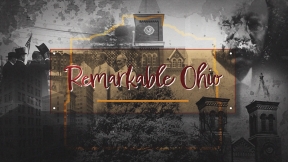

Archive
Broadcast
About



A SERVICE OF OHIO'S PUBLIC BROADCASTING STATIONS
A SERVICE OF OHIO'S PUBLIC BROADCASTING STATIONS
Program Directory

Lorenzo Lorraine Langstroth, is renowned as "The Father of American Beekeeping."
Langstroth was born in Philadelphia in 1810. During his childhood, he played with ants and bees on the city's gravel sidewalks, fascinated by the orderly kingdom of insects.
Eventually he ended up at Yale where he studied to become a clergyman and teacher, Langstroth had forgotten about the tiny creatures of his youth until 1838 - when the sight of a honeycomb in a large glass globe revived his curiosity. Immediately, he bought two hives and devoted himself to beekeeping and the study of their hives.
Beekeeping is believed to have originated in the Middle East. Early humans kept bees and traded the honey and beeswax. For several thousand years, beekeepers harvested honey and beeswax. The harvesting would inevitably kill the bee colonies.
Thirteen years after seeing that honeycomb under glass, Langstroth discovered the "bee space," an open space of not more than three-eighths of an inch, wide enough for a bee to fly through but narrow enough that it would not be filled with propolis, a resin material from sap and tree buds use by bees as cement.
This "Bee Space" discovery led him to develop the world's first moveable wooden framed beehive, patented in 1852. Langstroth revolutionized beekeeping and the honey industry by making it possible to remove and inspect the wooden frames without destroying the comb or harming the bees. This also helped to control disease and maintain a larger number of colonies.
Working with a local cabinet maker, Langstroth sold his wooden hives to beekeepers across the country. And his book, Langstroth on the Hive and the Honey Bee, in 1853, provided practical advice for bee management and is still in use.
Langstroth moved to Ohio and lived in Oxford with his wife, Anne, and their three children from 1858 to 1887.
Langstroth made experimental beehives, established an apiary, and on the ten acres that surrounded his home, grew buckwheat, clover, an apple orchard, and a "honey garden" of flowers.
Langstroth became one of the first Americans to import and sell a honey bee from Italy. Italian bees tend to start brood rearing early in the spring and continue until late fall, which results in a larger population throughout the active season. Today the Italian queen bee is the most popular commercial bee in North America.
Langstroth died on October 6, 1895, while giving a semon, in Dayton, where he lived with his daughter.
Appropriately, his tombstone in Woodlawn Cemetery reads "The Father of American Beekeeping."
Langstroth was born in Philadelphia in 1810. During his childhood, he played with ants and bees on the city's gravel sidewalks, fascinated by the orderly kingdom of insects.
Eventually he ended up at Yale where he studied to become a clergyman and teacher, Langstroth had forgotten about the tiny creatures of his youth until 1838 - when the sight of a honeycomb in a large glass globe revived his curiosity. Immediately, he bought two hives and devoted himself to beekeeping and the study of their hives.
Beekeeping is believed to have originated in the Middle East. Early humans kept bees and traded the honey and beeswax. For several thousand years, beekeepers harvested honey and beeswax. The harvesting would inevitably kill the bee colonies.
Thirteen years after seeing that honeycomb under glass, Langstroth discovered the "bee space," an open space of not more than three-eighths of an inch, wide enough for a bee to fly through but narrow enough that it would not be filled with propolis, a resin material from sap and tree buds use by bees as cement.
This "Bee Space" discovery led him to develop the world's first moveable wooden framed beehive, patented in 1852. Langstroth revolutionized beekeeping and the honey industry by making it possible to remove and inspect the wooden frames without destroying the comb or harming the bees. This also helped to control disease and maintain a larger number of colonies.
Working with a local cabinet maker, Langstroth sold his wooden hives to beekeepers across the country. And his book, Langstroth on the Hive and the Honey Bee, in 1853, provided practical advice for bee management and is still in use.
Langstroth moved to Ohio and lived in Oxford with his wife, Anne, and their three children from 1858 to 1887.
Langstroth made experimental beehives, established an apiary, and on the ten acres that surrounded his home, grew buckwheat, clover, an apple orchard, and a "honey garden" of flowers.
Langstroth became one of the first Americans to import and sell a honey bee from Italy. Italian bees tend to start brood rearing early in the spring and continue until late fall, which results in a larger population throughout the active season. Today the Italian queen bee is the most popular commercial bee in North America.
Langstroth died on October 6, 1895, while giving a semon, in Dayton, where he lived with his daughter.
Appropriately, his tombstone in Woodlawn Cemetery reads "The Father of American Beekeeping."
January 25, 2024


